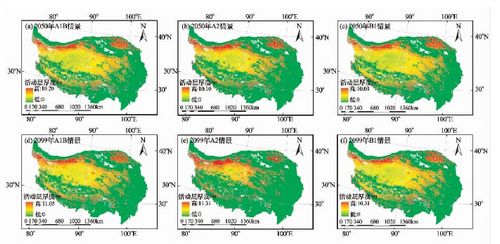Thermal conditions of shallow permafrost and in the active layer will change significantly under the combined influence of human activities and climate warming. The change will inevitably impact ecological, hydrological and engineering environments. Adopting changes in the mean annual air temperature under the climate change Scenarios A1B, A2 and B1 as the baseline, the changes of the active layer thickness are predicted by the Stefan's Equation for the permafrost regions on the Tibetan Plateau in Southwest China. It is found that the active layer depth will increase radically outwards from the Qiangtang basin in the interior of the Tibetan Plateau with rising air temperature under the projected climate scenarios. Changes in the active layer thickness under scenarios A1B and A2 will be more significant than that under scenario B1, because of lesser anthropogenic impacts. In 2050, the mean active layer thickness will reach 3.07 m under Scenario A1B, about 0.3~0.8 m more than that in 2010. At the same time, the increment will be 0.2~0.5 m under Scenario B1 and 0.2~0.55 m under scenario A2. In 2099, the mean active layer thickness will reach 3.42 m under scenario A1B, and 3.53 m under scenario A2. 2.93 m under scenario B1. Climate warming will significantly deepen the active layer. One hundred years later, the spatial distribution of permafrost will change largely.

Predicted active layer thickness as climate warming

